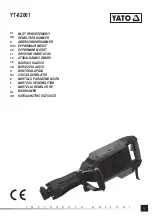
Section 4: Maintenance
MicroBlaster MB1002
Comco Inc.
4-4
Issue Date: July 2016
Parts Subject to Normal Wear
All the parts through which the abrasive flows are subject to wear. These include the
nozzles, hoses, hose connectors, and tank orifices. As a general rule, the smaller the
opening the abrasives flow through, the greater the possibility of wear. Parts also
subject to wear are the tank cover (threads) and modulator.
Hose
On a daily basis (or more often with heavy usage), hoses should be moved about 2"
through the pinch assemblies on the back panel (with air pressure off), increasing the
size of the loop. This will allow the pinch to squeeze the hose in a different spot. The
movement will greatly increase the life of the hoses. When the hoses have been moved
6", the direction of movement through the pinch should be reversed.
Note:
Care should be taken to maintain a 4-5" diameter loop in the hoses from the
fitting on the back panel to the pinch tube. Sharp bends will cause excessive
hose wear.
At weekly intervals, with the machine off, squeeze the handpiece abrasive hose between
thumb and forefinger in the area where the pinch valve has been operating, and along
the first 2 - 3 inches adjacent to the fitting at the rear panel. It should be evenly firm
along its length, without any soft spots. Whenever a soft spot is detected, the hose
should be cut back to that point and reattached to the fitting. See the procedures in
Section 5 to repair or replace the hose.
Hose Connectors
The connectors that attach the hoses to the rear panel of the MicroBlaster are also
subject to abrasive wear. Be sure to check them each time you replace hoses. Refer to
Section 5 of this manual when replacing hose or hose connectors.
Nozzles
Although manufactured from the hardest grade of tungsten carbide, nozzles are usually
subject to the greatest wear. They may start to bellmouth (widen) within a few hours and
be 50% oversize within a day, depending on the aggressiveness of the abrasive powder,
the pressure, and the duty cycle. Refer to Section 3 of this manual when changing
nozzles.
Tank Orifice
The orifices control the amount of abrasive deposited into the mixing chambers. Over
time, the orifices may become enlarged, allowing too much abrasive powder into the air
stream, causing clogging of small nozzles.
















































